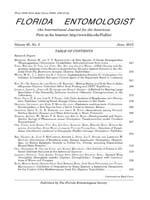The Asian citrus psyllid, Diaphorina citri Kuyawama (Hemiptera: Psyllidae), is a serious pest of citrus that vectors the phloem-limited nonculturable bacterium Candidatus Liberibacter asiaticus Jagoueix, Bové and Garnier (Jagoueix et al. 1994). The resulting disease is commonly referred to as citrus greening or huanglongbing (HLB) (Bové 2006). The psyllid was first reported from Florida in 1998 and citrus greening in 2005 (Halbert 1998, 2005).
Two species specific parasitic wasps, Tamarixia radiata (Waterston) (Hymenoptera: Eulophidae) and Diaphorencyrtus aligarhensis (Shafee, Alam and Argarwal) (Hymenoptera: Encyrtidae), were imported into Florida from Taiwan and Vietnam and released beginning in 1999 as biological control agents for D. citri (Hoy & Nguyen 1998). Tamarixia radiata has established in Florida (Qureshi et al. 2009), while D. aligarhensis has not.
An additional population of D. aligarhensis was collected in Guangdong province, China and sent to Gainesville, Florida in 2006. A colony was initiated in the Maximum Security Room of the Florida Biological Control Laboratory, Florida Department of Agriculture and Consumer Services, Division of Plant Industry. Parasitoids were held in quarantine through 20 generations before release permitting was complete and mass rearing began. Sixty-seven releases were made at 10 sites in 6 Florida counties (Alachua, Collier, DeSoto, Hendry, Orange and Polk) between 8/2007 and 10/2009, deploying a total of approximately 11,100 wasps (Table 1). Sites included commercial and private citrus groves as well as Murraya paniculata hedges. Wasps were either tapped out of holding tubes directly onto emerging plant shoots infested with immature psyllids or were released into cages consisting of fine mesh bags tied around new shoots infested with nymphs. Shoots were carefully inspected and predators removed prior to tying cages closed. Mesh size allowed parasitoid wasps to move freely in or out of the cage while preventing most predaceous insects from entering.
Released wasps successfully parasitized nymphs in the field and second generation wasps emerged. Evidence of this includes laboratory emergence of adult wasps from field clippings, D. aligarhensis parasitized mummies found on shoots covered with mesh cages, and several adult wasps sighted foraging on D. citri infested M. paniculata plants (Table 1).
All citrus groves used for wasp release, including certified organic groves, used pesticide sprays during the release period. The use of insecticides targeting D. citri likely reduced both psyllid and natural enemy populations (Qureshi & Stansly 2007). Murraya paniculata release sites were not subjected to any form of insect control, although occasional plant trimming by the property owners removed much of the new soft growth that D. citri uses for feeding and oviposition, consequently leaving few immature hosts for D. aligarhensis reproduction.
Adult psyllids were present at all locations throughout the release period although their incidence appeared to decline over the >2 year release period, likely from increased insecticide use to reduce the spread of citrus greening disease. During many trips to various locations for parasitoid release there was little to no host plant flush or immature psyllids present, particularly during late summer and fall.
Tamarixia radiata wasps were present at all release sites utilized in this study. Through the combined effect of host feeding and parasitism, a single female T. radiata can kill nearly twice as many psyllids in her lifetime as can a female D. aligarhensis (500 vs. 280, respectively) (Chien 1995). Additionally, T radiata has a shorter generation time and a higher reproductive rate (Skelley & Hoy 2004). Furthermore, any hosts parasitized by T. radiata before or within 5 d following parasitism by D. aligarhensis will result in T. radiata offspring (E. R. unpublished data). Thus, competition with T. radiata could present another impediment to establishment of D. aligarhensis.
Coccinellid predators were seen at all release sites. Generalist predators can induce high levels of psyllid mortality (Qureshi & Stansly 2009). Curinus coeruleus Mulsant, Cycloneda sanguinea (L.) and Harmonia axyridis Pallas readily consumed D. citri nymphs parasitized by D. aligarhensis (E. R. unpublished data) causing wasp mortality.
SUMMARY
Despite the release of thousands of D. aligarhensis in 2000–2002 (Tawain population) (Skelley & Hoy 2004) and over 11,000 in 2007–2009 (mainland China population), in numerous counties throughout the citrus growing regions of Florida, D. aligarhenisis appears not to have established to date. Factors contributing to this apparent failure include intense pesticide use to control D. citri, low and variable populations of immature psyllids, competition with T. radiata, and predation of parasitized hosts by generalist predators. Nevertheless, the 2 parasitoids are known to co-exist in many parts of Asia, and further efforts to establish D. aligarhensis in Florida are still warranted.
ACKNOWLEDGMENTS
Funding for this work was provided by the Florida Citrus Production Research Advisory Committee.







